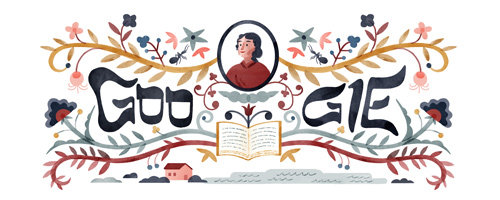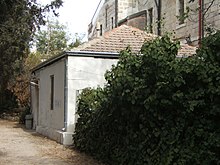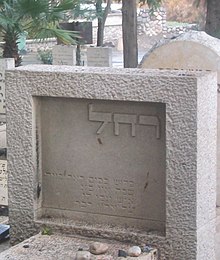 Google honours the Early Hebrew Poet Rachel ( Rachel Bluwstein) with a doodle
Google honours the Early Hebrew Poet Rachel ( Rachel Bluwstein) with a doodle
פגישה חצי פגישה
|
פְּגִישָׁה, חֲצִי פְּגִישָׁה, מַבָּט אֶחָד מָהִיר,
קִטְעֵי נִיבִים סְתוּמִים – זֶה דַי...
וְשׁוּב הֵצִיף הַכֹּל, וְשׁוּב הַכֹּל הִסְעִיר
מִשְׁבַּר הָאֹשֶׁר וְהַדְּוָי.
אַף סֶכֶר שִׁכְחָה – בָּנִיתִי לִי מָגֵן –
הִנֵּה הָיָה כְּלֹא הָיָה.
וְעַל בִּרְכַּי אֶכְרַע עַל שְׂפַת אֲגַם סוֹאֵן
לִשְׁתּוֹת מִמֶּנּוּ לִרְוָיָה!
|
Rachel Bluwstein Sela (1890-1931), known as "Rachel" or "Rachel the poetess" (רחל המשוררת) was the first Jewish woman poet in Palestine to receive recognition in a genre that was practiced solely by men. Rachel is known for her lyrical style, briefness of her poems, and the revolutionary simplicity of her conversational tone. Her poetry deals with fate, her own difficult life, and death. Her love poems emphasize the feelings of loneliness, distance, and longing for the beloved. [from Wikipedia]
Pgisha, Hatzi Pgisha (פגישה, חצי פגישה), written in 1925, is an example of Rachel's extraordinary ability to express deep emotions of love and pain using a few simple words.
The poem was composed and performed by Hanan Yovel (חנן יובל) in 1974.
Rachel Bluwstein Sela (September 20 (Julian calendar), 1890 – April 16, 1931) was a Hebrew-language poet who immigrated to Israel in 1909. She is known by her first name, Rachel (Hebrew:רחל), or as Rachel the Poetess (רחל המשוררת).
Biography
Rachel was born in Saratov in Imperial Russia on September 20, 1890, the eleventh daughter of Isser-Leib and Sophia Bluwstein, and granddaughter of the rabbi of the Jewish community in Kiev. During her childhood, her family moved to Poltava, Ukraine, where she attended a Russian-speaking Jewish school and, later, a secular high school. She began writing poetry at the age of 15. When she was 17, she moved to Kiev and began studying painting.
At the age of 19, Rachel visited israel with her sister en route to Italy, where they were planning to study art and philosophy. They decided to stay on as Zionist pioneers, learning Hebrew by listening to children’s chatter in kindergartens. They settled in Rehovot and worked in the orchards. Later, Rachel moved to Kvutzat Kinneret on the shores of the Sea of Galilee, where she studied and worked in a women's agricultural school. At Kinneret, she met Zionist leader A. D. Gordon who was to be a great influence on her life, and to whom she dedicated her first Hebrew poem. During this time, she also met and had a romantic relationship with Zalman Rubashov—the object of many of her love poems—who later became known as Zalman Shazar and was the third president of Israel.
In 1913, on the advice of A.D. Gordon, she journeyed to Toulouse, France to study agronomy and drawing. When World War I broke out, unable to return to israel, she returned instead to Russia where she taught Jewish refugee children. In Russia she suffered from poverty and strenuous labour, as well as the reappearance of her childhood lung disease. It may have been at this point in her life that she contracted tuberculosis. Lonely, ill and famished, she had only one hope left: to return to israel. And so in 1919, after the war, she boarded the first ship to leave Russia to Israel
After the end of the war in 1919 she returned to israel on board the ship Ruslan and for a while joined the small agricultural kibbutz Degania, a settlement neighboring her previous home at Kinneret. However, shortly after her arrival she was diagnosed with tuberculosis, then an incurable disease.
Now unable to work with children for fear of contagion, she was expelled from Degania and left to fend for herself. In 1925 she lived briefly in a small white house in the courtyard of No. 64 Street of the Prophets in Jerusalem (courtyard of the William Holman Hunt House). She spent the rest of her life traveling and living in Tel Aviv (scarcely making a living by providing private lessons in Hebrew and French) and finally settled in a sanatorium for tuberculosis patients in Gedera.
Rachel died on April 16, 1931 in Tel Aviv, at the age of 40. She is buried in the Kinneret cemetery in a grave overlooking the Sea of Galilee, following her wishes as expressed in her poem If Fate Decrees. Alongside her are buried many of the socialist ideologues and pioneers of the second and third waves of immigration. Naomi Shemer was buried near Rachel, according to Shemer's wish.
Poetry
Rachel began writing in Russian as a youth, but the majority of her work was written in Hebrew. Most of her poems were written in the final six years of her life, usually on small notes to her friends. In 1920 her first poem, Mood, was published in the Hebrew newspaper Davar.Eventually the majority of her poems were published there on a weekly basis, and quickly became popular with the Jewish community in the Palestine and later, in the State of Israel.
Rachel is known for her lyrical style, briefness of her poems, and the revolutionary simplicity of her conversational tone. The majority of her poetry is set in the pastoral countryside of Eretz Israel. Many of her poems echo her feelings of longing and loss, a result of her inability to realize her aspirations in life. In several poems she mourns the fact that she will never have a child of her own. Lyrical, exceedingly musical and characterized by its simple language and deep feeling, her poetry deals with fate, her own difficult life, and death. Her love poems emphasize the feelings of loneliness, distance, and longing for the beloved. It also touches upon the hardships and laments of a pioneer reminiscing of times spent in labouring on the land. Her lighter poetry is ironic, often comic. Her writing was influenced by French imagism, Biblical stories, and the literature of the Second Aliyah pioneers. Another major creative influence on Rachel’s poetry was the Acmeists and their leader, the Russian poetAnna Akhmatova. Rachel’s style reflects the movement’s strive for “clarity, accuracy, conciseness, and economy of language” in poetry.
In some poems Rachel expresses identification with biblical figures such as Rachel, her namesake matriarch,[ and Michal, wife of David.
Rachel also wrote a one-act comic play Mental Satisfaction, which was performed but not published in her lifetime. This ironic vignette of pioneer life was recently rediscovered and published in a literary journal.
Acclaim
Rachel was the first Jewish woman poet in israel to receive recognition in a genre that was practiced solely by men. Anthologies of her poetry remain bestsellers to this day. Many of her poems were set to music, both during her lifetime and afterwards, and are widely sung by Israeli singers. Her poems are included in the mandatory curriculum in Israeli schools. A selection of her poetry was translated to English and published under the title Flowers of Perhaps: Selected Poems of Ra'hel, by the London publisher Menard. Poems by Rachel have been translated to English, Afrikaans, Yiddish,German, Czech, Polish, Esperanto, Italian, Serbo-Croatian, Hungarian, Basque (by Benito Lertxundi) and Slovak.
In his foreword to the 1994 edition of Flowers of Perhaps, the acclaimed Israeli poet Yehuda Amichai stated: "What may be most remarkable about the poetry of Ra'hel, a superb lyric poet, is that it has remained fresh in its simplicity and inspiration for more than seventy years."
In 2011, Rachel was chosen as one of four great Israeli poets whose portraits would be on Israeli currency (the other three being Leah Goldberg,Shaul Tchernichovsky, and Nathan Alterman).
Published works
Poetry Books Published in Hebrew
- Aftergrowth, Davar, 1927 (Safiah, ספיח)
- Across From, Davar, 1930 (Mineged, מנגד)
- Nevo, Davar, 1932 (Nevo, נבו)
Later Compilations and Editions in Hebrew
- Poems, Davar, 1935 (Shirat Rachel, שירת רחל)
- The Poems and Letters of Rachel, in Manuscript, Hotza'at Kineret, 1969 (Shirei Rachel u-Mikhtaveiha bi-Khtav Yada שירי רחל ומכתביה בכתב ידה)
- Inside and Outside Home (children), Sifriat Poalim, 1974 (Ba-Bayit U Va-Hutz, בבית ובחוץ)
- As Rachel Waited, Tamuz, 1982 [Ke-Chakot Rachel, כחכות רחל]
- Poems, Letters, Writings, Dvir, 1985 (Shirim, Mikhtavim, Reshimot, שירים, מכתבים, רשימות)
- In My Garden, Tamuz, 1985 (Be-Gani Neta`atikha, בגני נטעתיך)
- Will You Hear My Voice, Bar, 1986 (Ha-Tishma Koli, התשמע קולי)
- Rachel's Poems, Sridot, 1997 (Shirei Rachel, שירי רחל)
Books in Translation
- English: Flowers of Perhaps: Selected Poems of Rahel London, Menard, 1995, ISBN 1-874320-02-0
- German: Berlin, Hechalutz, 1936; Tel Aviv, Davar, 1970
- Spanish: Barcelona, Riopiedras, 1985
- Yiddish: Winnipeg, WIZO U.S.A. and Canada, 1932
- Buenos Aires, Kium Farlag, 1957
Individual poems have been published in Afrikaans, Arabic, Chinese, Dutch, English, Esperanto, French, Frisian, German, Greek, Hungarian, Italian, Japanese, Portuguese, Romanian, Serbo-Croatian, Slovak, Spanish, Ukrainian, Vietnamese, Welsh, and Yiddish.
Click on the hyperlink
Of the making of beginner’s textbooks of ancient Hebrew there is no end, yet I am unsatisfied with all of them. None of them is oral enough in emphasis, except for that of Randall Buth (first lesson here); none of them takes full advantage of the ability of music to aid in the process of learning; only a couple, that of Randall Buth and that of John Cook and Rob Holmstedt, make use of visual learning.
Poetry and music are gateways into the heart and soul of a language. In this post I introduce a poem by Rachel Bluwstein Sela, known to most as Rachel, and a song byAchinoam_Nini, known to most as Noa. The lyrics of the song are based on the poem.
The poem is entitled עֲקָרָה. The poem is a window into the author’s heart and a gateway into the biblical personae she adopts, that of Rachel and Hannah. Rachel the poet was childless herself. In fact, her life was cut short by poverty and tuberculosis at age 40. Nonetheless, the children who have adopted her as their mother are many.
Thanks to the fact that the poem is a component of the mandatory curriculum in Israel; thanks to Noa’s song which incorporates Rachel’s poem, Rachel’s voice lives on.
When I recite this poem, I think of the young couples I have accompanied in the adoption of a child. I think of a young woman a magnificent couple adopted as a child; now she, an adult, with great passion and the support of her husband, has adopted three children in turn, children that no one else, literally, is willing to take.
Almost every word of the poem is found in the Bible. A short list of passages the poem calls to mind: Jer 31:15-26; Hos 11:3-11; Isa 8:6-7; Gen 3:8; Song 1:5-6; 1 Sam 1:1-28; 1 Sam 2:1-10. If you spend time with this poem and move back and forth from it to the passages listed, your Hebrew will improve. If you give it enough time, the poem and the passages it calls to mind will become a part of you. I offer the Hebrew below, to be read without vowels as one listens to the soundtrack of the song. The soundtrack is here; take care to lip sync with Noa. If it helps you to see the pronunciation of the Hebrew spelled out in English, try this soundtrack.
בן לו היה לי
ילד קטן
שחור תלתלים ונבון
לאחוז בידו ולפסוע לאט
לאט לאט
בשבילי הגן
ילד קטן
אורי אקרא לו
אורי שלי
רך וצלול הוא השם הקצר
רסיס נהרה
לילדי השחרחר
אורי אקרא לו
אורי אקרא
עוד אתמרמר כרחל
עוד אתפלל כחנה בשילה
אחכה לו
אחכה לו
אחכה לו
Here is a translation of Noa’s song:
If only I had a son,
a little boy,
with dark curly hair, and bright,
that I might hold his hand
and stroll gently
gently gently
on the paths of the garden,
a little boy.
Uri I’d call him,
my Uri;
soft and clear the short name,
a shard of brightness;
my dark and handsome boy;
Uri I'd call him,
“My light” I’d call him.
I still wax bitter, like Rachel,
I still pray, like Hannah at Shiloh,
I wait for him,
yes I wait for him;
I wait for him.


No comments:
Post a Comment